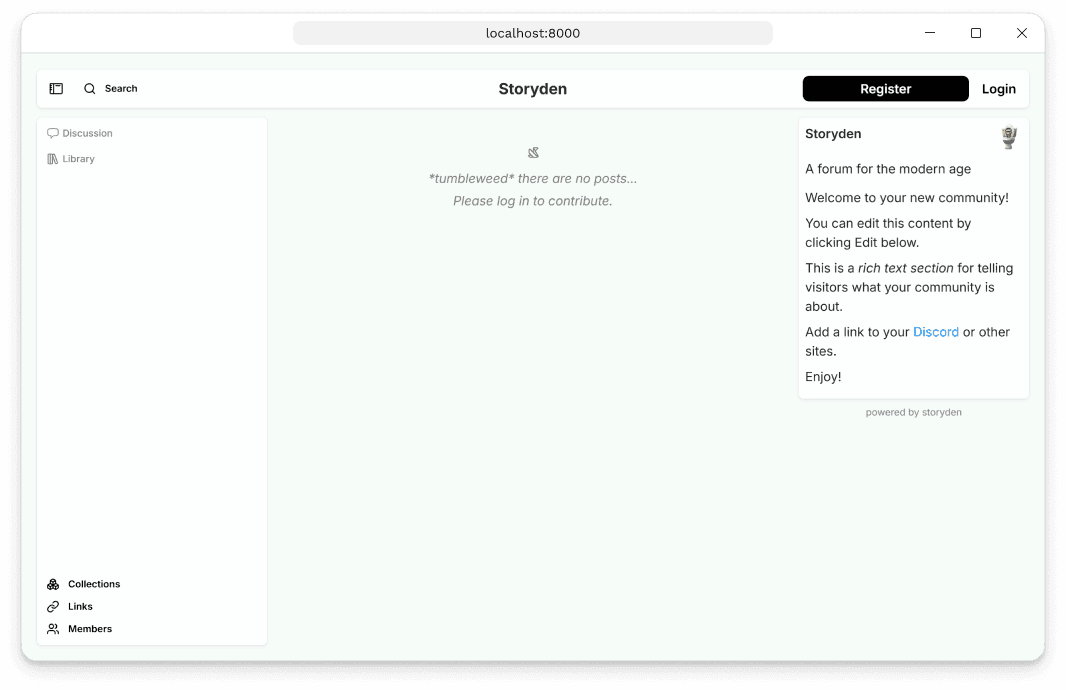Docker
Setting up a Storyden container with Docker
Getting an instance of Storyden online is criminally easy. There's almost zero configuration required and lots of sane defaults which you can adapt later as needed.
Note that this guide assumes you already have SSL termination set up for your server. Storyden does not accept HTTPS connections and always assumes that it's behind a load balancer or reverse proxy. We recommend Caddy as an easy to set up reverse proxy.
Running the container
You can spin up a local Storyden instance using Docker. The main Docker image includes both frontend and API services and can be started with:
docker run -p 8000:8000 ghcr.io/southclaws/storydenThis will start the full stack (API and web interface) accessible at http://localhost:8000.

The first account that is registered will automatically be given the Admin role which provides you all permissions. When deploying a new public instance, be careful with how long you leave the freshly deployed instance without registering the admin account.
API only
If you're looking to just play with the API, you can run the API-only container image:
docker run -p 8000:8000 ghcr.io/southclaws/storyden:edge-backendThis will run the API at http://localhost:8000 and you can check the OpenAPI documentation at http://localhost:8000/api/docs.
All CORS and cookie rules are default configured to support localhost:8000 out of the box.

Configuration
When running a production instance of Storyden, you must set some configuration values to ensure basic functionality and security.
Storyden's infrastructure-level configuration is applied via environment variables. You can read more about the available options here.
For this guide, we'll focus on the bare minimum to get up and running.
PUBLIC_WEB_ADDRESS
This is the frontend address, or, the URL users will visit in their browser. More info.
Example: PUBLIC_WEB_ADDRESS=https://the-secret-agent.club
PUBLIC_API_ADDRESS
This is the API address, where the web frontend sends API calls. More info.
Example: PUBLIC_API_ADDRESS=https://api.the-secret-agent.club
These can be the same, for example when running the full-stack image and both your browser requests and API requests go to the same container. In this case, set both environment variables to the same value.
Mounting /storyden/data
Storyden does not depend on external services by default, so unless you specify, persistent storage such as the database and assets are stored on the local disk.
- If you haven't specified a
DATABASE_URLa local embedded SQLite database will be used. - If you haven't specified a
ASSET_STORAGE_TYPEuploaded files will be stored to disk.
The Docker image data directory is /storyden/data which is set as a volume by default, if you want to mount a local directory instead of a Docker-managed volume, you can specify the --volume flag and bind it to a directory on your host machine's filesystem.
All together
Using Docker's managed volume:
docker run \
--name storyden \
--publish 8000:8000 \
--env PUBLIC_WEB_ADDRESS=https://the-secret-agent.club \
--env PUBLIC_API_ADDRESS=https://api.the-secret-agent.club \
ghcr.io/southclaws/storydendocker run --name storyden --publish 8000:8000 --env PUBLIC_WEB_ADDRESS=https://the-secret-agent.club --env PUBLIC_API_ADDRESS=https://api.the-secret-agent.club ghcr.io/southclaws/storyden(docker run
--name storyden
--publish 8000:8000
--env PUBLIC_WEB_ADDRESS=https://the-secret-agent.club
--env PUBLIC_API_ADDRESS=https://api.the-secret-agent.club
ghcr.io/southclaws/storyden)Or with a directory mounted into the container:
docker run \
--name storyden \
--publish 8000:8000 \
--volume /my/local/storyden/data:/storyden/data \
--env PUBLIC_WEB_ADDRESS=https://the-secret-agent.club \
--env PUBLIC_API_ADDRESS=https://api.the-secret-agent.club \
ghcr.io/southclaws/storydendocker run --name storyden --publish 8000:8000 --volume /my/storyden/data:/storyden/data --env PUBLIC_WEB_ADDRESS=https://the-secret-agent.club --env PUBLIC_API_ADDRESS=https://api.the-secret-agent.club ghcr.io/southclaws/storyden(docker run
--name storyden
--publish 8000:8000
--volume /my/storyden/data:/storyden/data
--env PUBLIC_WEB_ADDRESS=https://the-secret-agent.club
--env PUBLIC_API_ADDRESS=https://api.the-secret-agent.club
ghcr.io/southclaws/storyden)Next Steps
Now you've got an instance running, you must expose it to the internet using a reverse proxy. Storyden does not accept HTTPS connections but it requires that the site itself run on a HTTPS address for security reasons.
We recommend using something like Caddy or Traefik to act as a reverse proxy that handles HTTPS.
Alternatively, you can expose Storyden's container on port 80 and use Cloudflare to handle SSL termination.
--publish 80:8000